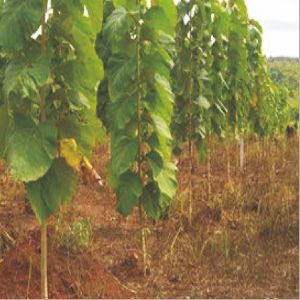
Teak Plant
109 Per Piece
10 Piece(s) (MOQ)
Height When Fully Grown : Upto 20 Meter
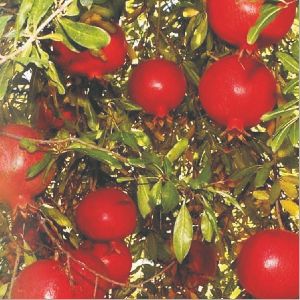
Pomegranate Plant
199 Per Piece
10 Piece(s) (MOQ)
Planting Guide Pomegranate seeds germinate well at the normal room temperature in about 30-40 days. To cut the time by half, the soil temperature can be increased by a few degrees. The plant can be surrounded with foil and placed under direct sunlight for the seedlings to sprout. Benefits The pomegranate fruit and its juice can be used for culinary purposes. The plant is also used for ornamental purposes because of its brightly coloured flowers.
...more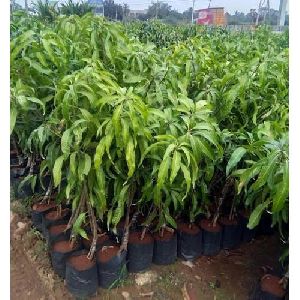
Mango Plant
199 Per Piece
10 Piece(s) (MOQ)
Mango trees grow to 35–40 m (115–131 ft) tall, with a crown radius of 10 m (33 ft). The trees are long-lived, as some specimens still fruit after 300 years.[10] In deep soil, the taproot descends to a depth of 6 m (20 ft), with profuse, wide-spreading feeder roots and anchor roots penetrating deeply into the soil.[1] The leaves are evergreen, alternate, simple, 15–35 cm (5.9–13.8 in) long, and 6–16 cm (2.4–6.3 in) broad; when the leaves are young they are orange-pink, rapidly changing to a dark, glossy red, then dark green as they mature.[1] The flowers are produced in terminal panicles 10–40 cm (3.9–15.7 in) long; each flower is small and white with five petals 5–10 mm (0.20–0.39 in) long, with a mild, sweet fragrance.[1] Over 500 varieties of mangoes are known,[1] many of which ripen in summer, while some give a double crop.[11]The fruit takes four to five months from flowering to ripen.
Other Necessities : Well Watered
Packaging Type : Plastic Bag
Soil Specific : Well Drained
...more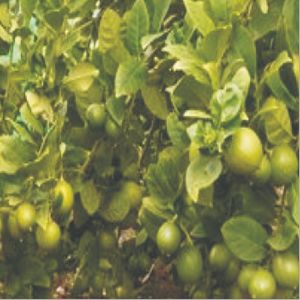
Lemon Plant
200 Per Piece
10 Piece(s) (MOQ)
In India, in terms of area under cultivation, citrus is the third largest fruit industry after Banana and Mango.When you grow a lemon tree in a pot, there are a few things you need to keep in mind. First of all, container lemon trees will not get as large as lemon tree grown in the ground. When growing lemon trees in containers, the needs are very similar to lemon trees growing in the ground. The lemon trees will need good drainage, so make sure the pot has drainage holes.Tending a small lemon tree in your home can be a delightful aromatic experience. While the thought of growing a tree inside a house or apartment may seem daunting to beginners, it is not as difficult as it may sound.Common name(s): Nimboo, Limboo.limeFlower colours: –Bloom time: annualMax reacahble height: 2 to 6 feet.Difficulty to grow:: Easy. Planting and care Citrus trees need a warm or mild climate zone. As long as frosts are not severe citrus trees will tolerate cool conditions. In cold zones grow only container versions, so when temperatures really plummet, bring them inside a greenhouse or enclosed porch.Citrus need full sun, so place them in the sunniest part of your garden or balcony. Pots must have drainage holes in their base and be elevated slightly off the ground. Water potted citrus two to three times a week, and possibly daily in very hot weather. Apply citrus food in small amounts monthly from August to mid autumn.Sunlight: Full sun, Partial sunSoil: Citrus orchards flourish well in light soils with good drainage properties. Deep soils with pH range of 5.5 to 7.5 are considered ideal.Water: Water them regularly, about once a week in hot weather.Temperature: Citrus fruits grow best between a temperature range of 13 degree C to 37 degree C.Fertilizer: Feed them fertiliser often (at the drip line, rather than near the trunk). Caring for Nimboo Citrus trees need a warm or mild climate zone. As long as frosts are not severe citrus trees will tolerate cool conditions. In cold zones grow only container versions, so when temperatures really plummet, bring them inside a greenhouse or enclosed porch. Citrus need full sun, so place them in the sunniest part of your garden or balcony. Pots must have drainage holes in their base and be elevated slightly off the ground. Water potted citrus two to three times a week, and possibly daily in very hot weather. Apply citrus food in small amounts monthly from August to mid autumn.
Color : Green
Occasion : Summer
Climate : Subtropics
Benefit : Fast Growing Plant
...more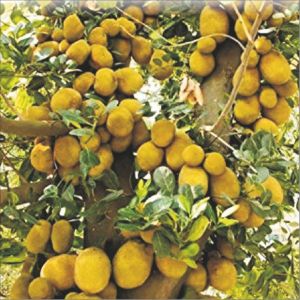
Jackfruit Plant
199 Per Piece
10 Piece(s) (MOQ)
Growing jackfruit trees have flowers borne on short branches extending from the trunk and older branches. This otherworldly looking oddity has a very thick, rubbery rind with short blunt spikes and up to 500 seeds. The average fruit is around 35 pounds.All parts of the jack-fruit tree produce opalescent, sticky latex and the tree has a very long tap-root. Growing jack-fruit trees have flowers borne on short branches extending from the trunk and older branches.Common name(s): Fanas, Jackfruit, KathalFlower colours: Pale greenBloom time: Spring, SummerMax reacahble height: 80 feet.Difficulty to grow:: Easy to grow Planting and care Jackfruit can propagate by softwood grafting. Large scale propagation of jackfruit can be done by cleft grafting during July-August on 4-month-old seedling rootstock. Dig pits of 1 m x 1 m x 1 m, fill up the pits with topsoil mixed with 10 Kg of FYM and 1 Kg of neem cake per pit at the time of planting.Sunlight: Full sun.Soil: Rich, deep and somewhat porous soil.Water: Keep the soil moist but do not overwater.Temperature: 25 to 35 degree CFertilizer: Apply any organic fertilizer. Caring for Jack Fruit Jackfruit care dictates the removal of dead wood and thinning of the growing jackfruit tree. Pruning to keep the jackfruit at about 15 feet high will also facilitate harvesting. Keep the tree roots damp but not wet. Typical uses of Jack Fruit Special features: Fruit shaped like an enormous kidney bean, they have pebbled and rough green skin, and their flavour is indescribable. They are sweet and mild and best served cold. Culinary use: The pulp of the ripe fruit is eaten fresh or in syrup. Immature fruit is used for culinary purpose. Ornamental use: NA Medicinal use: Ripe fruit is a valuable source of carbohydrates with a lesser amount of calcium and phosphate.
...more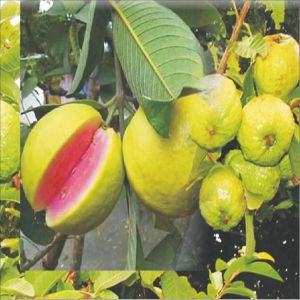
Guava Plant
199 Per Piece
10 Piece(s) (MOQ)
Description Guava fruit trees (Psidium guajava) are not a common sight in North America and need a decidedly tropical habitat. In the United States, they are found in Hawaii, the Virgin Islands, Florida and a few sheltered areas in California and Texas. The trees are very frost tender and will succumb to a freeze when young, although adult trees may survive short periods of cold. That said, the plants are attractive and produce deliciously rich, sweet fruits that are excellent fresh or in desserts. Given enough guava tree information, it is possible to grow these small trees in a greenhouse or sunroom and reap the benefits of their Vitamin C-rich fruits. Guava Plants and Guava Tree Information The guava fruit grows on a small tree with a wide, short canopy and a sturdy single to multi-stemmed trunk. The guava tree is an interesting plant with mottled greenish bark and long 3- to 7-inch serrated leaves. Guava trees produce white, 1-inch flowers that yield to small round, oval or pear shaped fruits. These are more accurately berries and have soft flesh, which may be white, pink, yellow or even red and varies in taste from acidic, sour to sweet, and rich depending on variety.
Soil Specific : Well Drained
...more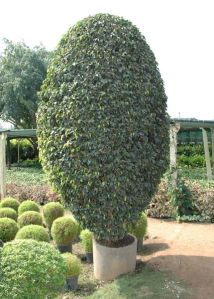
Ficus Plant
299 Per Piece
100 Piece(s) (MOQ)
Description Ficus is a pan-tropical genus of trees, shrubs and vines occupying a wide variety of ecological niches; most are evergreen, but some deciduous species are endemic to areas outside of the tropics and to higher elevations. Fig species are characterized by their unique inflorescence and distinctive pollination syndrome, which utilizes wasp species belonging to the family Agaonidae for pollination. The specific identification of many of the species can be difficult, but figs as a group are relatively easy to recognize. Many have aerial roots and a distinctive shape or habit, and their fruits distinguish them from other plants. The fig fruit is an enclosed inflorescence, sometimes referred to as a syconium, an urn-like structure lined on the inside with the fig’s tiny flowers. The unique fig pollination system, involving tiny, highly specific wasps, known as fig wasps that enter via ostiole these sub-closed inflorescences to both pollinate and lay their own eggs, has been a constant source of inspiration and wonder to biologists. Finally, there are three vegetative traits that together are unique to figs. All figs possess a white to yellowish latex, some in copious quantities; the twig has paired stipules or a circular stipule scar if the stipules have fallen off; and the lateral veins at the base of the leaf are steep, forming a tighter angle with the midrib than the other lateral veins, a feature referred to as “tri-veined”. There are no unambiguous older fossils of Ficus. However, current molecular clock estimates indicate that Ficus is a relatively ancient genus being at least 60 million years old, and possibly as old as 80 million years. The main radiation of extant species, however, may have taken place more recently, between 20 and 40 million years ago. Some better-known species that represent the diversity of the genus include the common fig, a small temperate deciduous tree whose fingered fig leaf is well known in art and iconography; the weeping fig (F. benjamina), a hemi-epiphyte with thin tough leaves on pendulous stalks adapted to its rain forest habitat; the rough-leaved sandpaper figs from Australia; and the creeping fig (F. pumila), a vine whose small, hard leaves form a dense carpet of foliage over rocks or garden walls. Moreover, figs with different plant habits have undergone adaptive radiation in different biogeographic regions, leading to very high levels of alpha diversity. In the tropics, it is quite common to find that Ficus is the most species-rich plant genus in a particular forest. In Asia as many as 70 or more species can co-exist. Ficus species richness declines with an increase in latitude in both hemispheres. Ficus is a pan-tropical genus of trees, shrubs and vines occupying a wide variety of ecological niches; most are evergreen, but some deciduous species are endemic to areas outside of the tropics and to higher elevations. Fig species are characterized by their unique inflorescence and distinctive pollination syndrome, which utilizes wasp species belonging to the family Agaonidae for pollination.
Other Necessities : Full Sun Exposure, Well Watered
...more
Eucalyptus Plant
35 Per Piece
80 Piece(s) (MOQ)
Length : 8 - 12 Feet
Application : Planting
Feature : Environment Friendly, Moisture Proof,Well Processed
Packaging Type : PP Grow Bag
...more
Bottle Palm Plant
299 Per Piece
10 Piece(s) (MOQ)
Description Bottle palm has a large swollen (sometimes bizarrely so) trunk. It is a myth that the trunk is a means by which the palm stores water. Bottle palms have only four to six leaves open at any time. The leaves of young palms have a red or orange tint, but a deep green is assumed at maturity. The flowers of the palm arise from under the crownshaft. This species is often confused with its relative, the Spindle Palm, which also has a swollen trunk. However the Spindle palm’s trunk swells in the middle (resembling the shape of a spindle), whereas the trunk of the Bottle palm swells from near the base and tapers further up. Its inflorescence branches in 4 orders, and its 2.5 cm fruits can be orange or black. The trunk of both species becomes more and more slender as the palm ages. Bottle palms are very cold sensitive and are killed at 0 °C (32 °F) or colder for any appreciable length of time. They may survive a brief, light frost, but will have foliage damage. Only southern Florida and Hawaii provide safe locations in the USA to grow Bottle Palm, although mature flowering specimens may be occasionally be seen in favored microclimates around Cape Canaveral and Tampa-St. Petersburg-Clearwater in coastal central Florida. It makes a fine container-grown palm in other locations as long as it is protected from the cold and not overwatered. Bottle palm has a large swollen (sometimes bizarrely so) trunk. It is a myth that the trunk is a means by which the palm stores water. Bottle palms have only four to six leaves open at any time. The leaves of young palms have a red or orange tint, but a deep green is assumed at maturity. The flowers of the palm arise from under the crownshaft. This species is often confused with its relative, the Spindle Palm, which also has a swollen trunk. However the Spindle palm’s trunk swells in the middle (resembling the shape of a spindle), whereas the trunk of the Bottle palm swells from near the base and tapers further up. Its inflorescence branches in 4 orders, and its 2.5 cm fruits can be orange or black. The trunk of both species becomes more and more slender as the palm ages.
Application : Gardening & Landscaping Trees
Feature : Longer Shelf Life
...more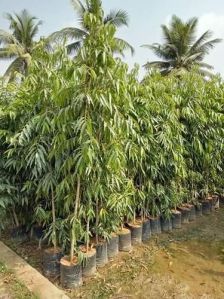
Ashoka Plant
299 Per Piece
10 Piece(s) (MOQ)
Description : The ashoka is a rain-forest tree. Its original distribution was in the central areas of the Deccan plateau, as well as the middle section of the Western Ghats in the western coastal zone of the Indian subcontinent. The ashoka is prized for its beautiful foliage and fragrant flowers. It is a handsome, small, erect evergreen tree, with deep green leaves growing in dense clusters. Its flowering season is around February to April. The ashoka flowers come in heavy, lush bunches. They are bright orange-yellow in color, turning red before wilting. Biologically, some of the flower’s characteristics are very dry and abundant. This means that the flower is coated with a chemical on the outside.Its flowering season is around February to April. The ashoka flowers come in heavy, lush bunches. They are bright orange-yellow in color, turning red before wilting.
Other Necessities : Full Sun Exposure
Soil Specific : Acidic
Sunlight : Partial Sun
...more
Lemon Plant

Eucalyptus Plant
Be first to Rate
Rate ThisOpening Hours
Kisan Growth Technology Pvt. Ltd. is an enterprising organization from Jalaun (Uttar Pradesh) that marked an impressive foray in the trading business, involving a diverse range of nursery plants. We serve as a dependable supplier (wholesaler & retailer) of premium quality decoration plants, fruit plants, timber plants, jackfruit plant, and lemon plant. We procure these plants only from reliable vendors and horticulturists in the market, hence the quality of the plants is always assured for. The plants, offered by us, are widely demanded in the market owing to their supreme quality and cost-effectiveness.
Kisan Growth Technology Pvt. Ltd. is a Jalaun (Uttar Pradesh) based company, which is operating in the agriculture industry since 2020. Working in the industry with commitment, we have been providing the clients with the top-notch quality fresh and healthy decoration plants, fruit plants, timber plants, jackfruit plant, and lemon plant. The company has been led by a hardworking and dedicated professional i.e. Mr. Sandeep Kumar (Company Founder).
Quality Assurance
We are recognized in the market for our wide array of quality assured products. Further, in order to maintain the quality and avoid any kind of flaw, each of the offered products is precisely tested against various quality parameters before final delivery.
Why Us
With years of industry knowledge and experience, Kisan Growth Technology Pvt. Ltd. has attained a remarkable place in the area of operations. A few other trade traits that make us a preferred choice of the clients are listed below:
Impressive product resourcing capabilities
Timely delivery of consignments
Easy payment options
Competitive prices